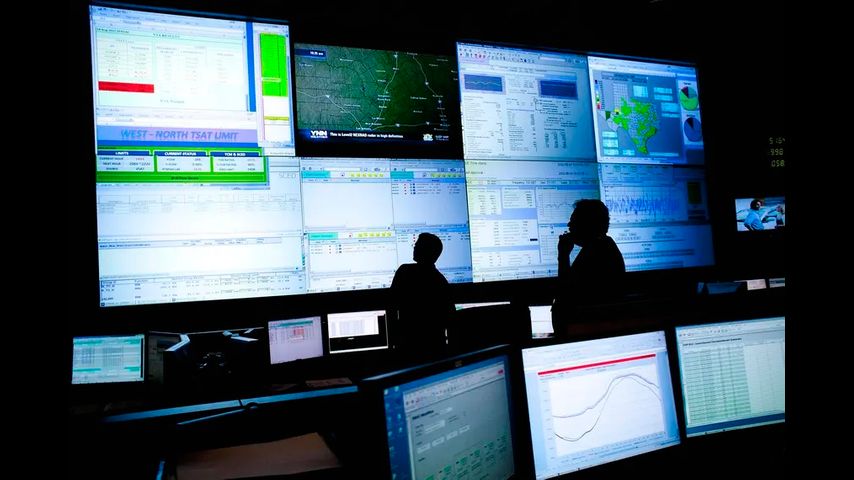Texas power grid expected to handle brutally cold temperatures
Sign up for The Brief, The Texas Tribune’s daily newsletter that keeps readers up to speed on the most essential Texas news.
Texans should prepare for several days of cold weather during which temperatures may not rise above freezing, potentially snapping pipes and dropping tree limbs on power lines, Gov. Greg Abbott said Friday.
But he and other state leaders remain confident that the state’s main power grid will hold through what’s being called an “arctic blast.”
“We feel very good about the status of the Texas power grid and [Electric Reliability Council of Texas] to be able to effectively and successfully ensure that the power is going to stay on throughout the entirety of this winter storm episode,” Abbott said.
[How Texans can prepare for extreme weather]
The frigid weather across the entire state is expected to start on Saturday and remain until Wednesday, Abbott said. Tuesday morning and Wednesday morning will present the most strenuous periods for the state’s power grid due to less wind as the sun is rising and anticipated high demand for electricity while people start their days and try to stay warm.
However, Abbott reassured that power generators have been inspected and winterized, and that officials have second sources of fuel available to keep the grid up during the tight stretches.
The governor said such preparation distinguished the arriving cold snap from Winter Storm Uri in 2021, when a freeze arrived before Valentine’s Day that year and plunged temperatures, causing all types of power generators to fail. Natural gas production faltered, a problem for power plants that rely on it. In order to prevent a complete grid collapse, electric grid operators cut power to millions who were trying to stay warm. At least 246 people died during the storm, per the state’s official count, though some estimates are higher.
The upcoming period of cold conditions is not expected to last as long as 2021’s freeze, Abbott said.
“This will be one of the coldest episodes they will have lived through in the state of Texas. It will last for several days but it will not be anything close to what we experienced during Winter Storm Uri,” Abbott said. “We are much, much more prepared for this.”
As of Friday morning, Abbott said, some weather models show there may be some precipitation in parts of Central and East Texas — and cautioned that conditions could change rapidly.
In case of precipitation during such cold temperatures, emergency officials urged people to remain off roads that could become glazed with ice that’s difficult to see. Freezing precipitation can also weigh down tree limbs that knock out power, causing localized outages that state leaders said should be reported to local power providers.
The Electric Reliability Council of Texas, which operates the state’s main grid, has issued what it calls a “weather watch” calling on people to be aware that it expects power demand to be high between Monday and Wednesday. ERCOT must make sure electricity demand never exceeds supply or else the grid can be catastrophically damaged; the margin between supply and demand could get low during those days.
As of mid-morning Friday, ERCOT forecasts showed power generators should be able to meet what they expected to be significant power demand. On both Tuesday and Wednesday, ERCOT was bracing for demand to exceed 84,000 megawatts; last January, the highest demand was 65,632 megawatts. (One megawatt can power about 200 homes during high demand.)
Grid issues have been politically fraught since the deadly 2021 storm. Legislators in 2021 required power plants to winterize their equipment better. In 2023, state politicians passed measures designed to get more gas-fueled power plants built on the grid, arguing that Texas needed power sources that can come on anytime, unlike wind or solar power that rely on the wind to blow or the sun to shine.
Last year, ERCOT asked Texans to conserve power voluntarily more than 10 times. Demand for power was higher than ever — hitting a record 85,508 megawatts in August — as the growing state weathered its hottest year ever recorded. Climate change driven by greenhouse gas emissions created from activities such as burning oil and gas is pushing temperatures hotter around the globe.
For months, the grid operator has expected that, at 8 a.m. on any given day in January, there could be a nearly 8% chance of going into emergency conditions and a nearly 7% chance of calling for power cuts. In the event of a strong winter storm, they put those risks at almost 21% and 17%, respectively. In October, calling that an “unacceptable” risk, ERCOT asked companies if they would bring old gas or coal fired plants back online.
No company said they would bring an old plant back online. ERCOT President and CEO Pablo Vegas then said that request had been an “extra layer of precaution.”
“There’s not an expectation of an energy emergency and we are not calling for conservation at this point in time. Now, things can change and if it does change we’ll continue to communicate openly over the course of this weekend,” Vegas said Friday. “The grid is better prepared than it’s ever been before.”
This article originally appeared in The Texas Tribune at https://www.texastribune.org/2024/01/12/texas-power-grid-conservation-arctic-blast/.
The Texas Tribune is a member-supported, nonpartisan newsroom informing and engaging Texans on state politics and policy. Learn more at texastribune.org.





